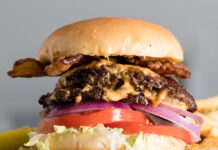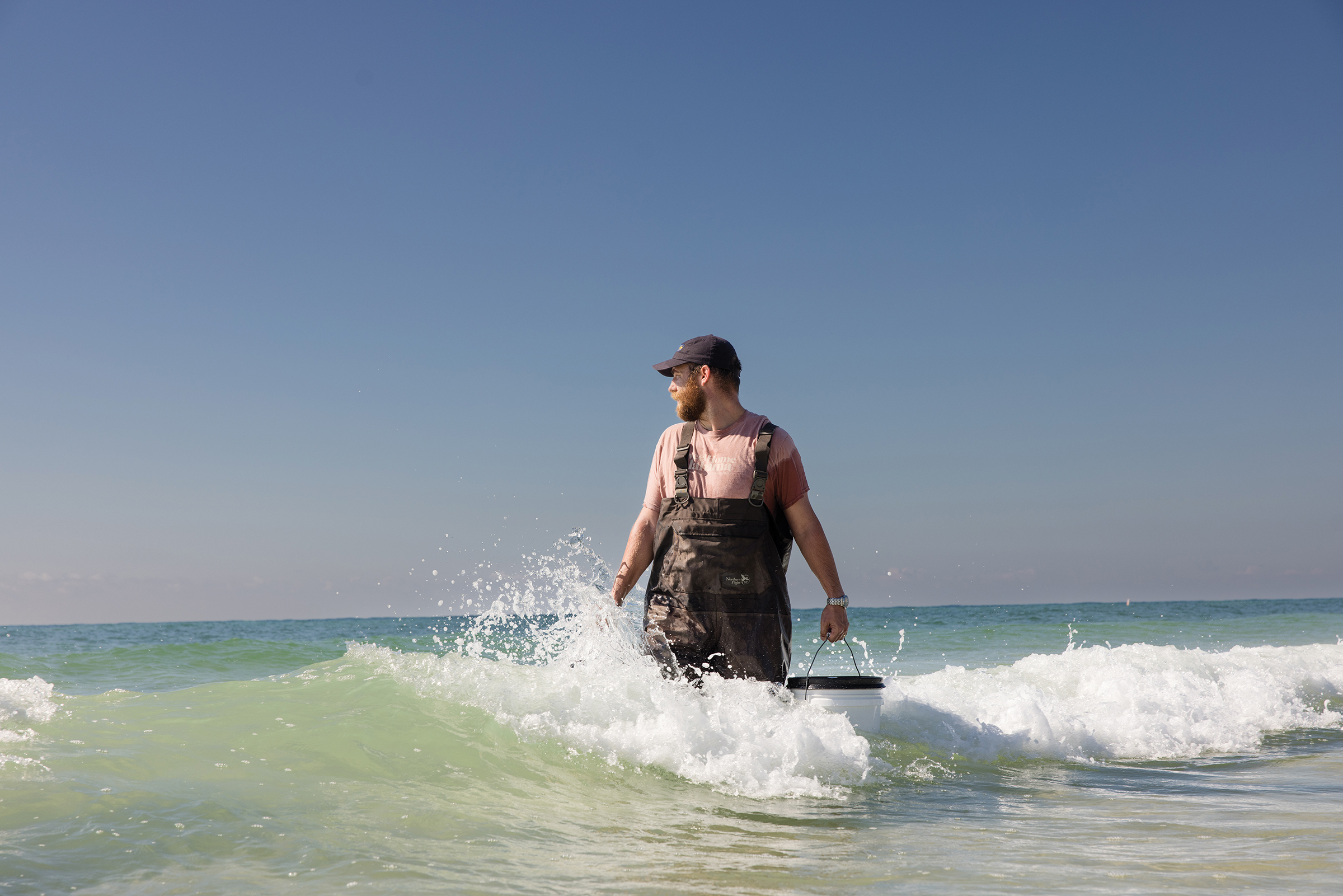
Trey King gets an early start, arriving at The Hangout in Gulf Shores at around 6 a.m. from his Fairhope house. The salty air blows across the waves as their rhythmic in-out, in-out sounds into the darkness, the sun still below the horizon at this time of morning. This is the world where he begins salt harvesting.
Wearing waders and armed with food-safe, 5-gallon buckets, he splashes as far as he can go into the water, around 50 feet out. He scoops up the water, trudges back to the shore, puts a lid on his bucket, and heaves it into his truck. He repeats this process until each bucket is full. “You have to go first thing in the morning because that’s all the cleanest water coming in,” he explains. “Once people start getting in the water, sunscreen, contaminants and all types of other things will get in the water, too.”
The sun has risen once he’s pulled into his driveway in Fairhope. He unloads the buckets out of the truck bed, covered in sand and water drops, and gets in quite the workout in the process. “In doing this, I didn’t realize how much I was signing up for,” he says with a good-natured smirk as he deposits a bucket on the ground. “Salt water weighs about nine pounds per gallon, so it’s really heavy. These buckets each weigh 45 pounds.” He wipes his brow and continues.
King didn’t launch into salt harvesting through family connections, adjacent industry crossover or an inherited company. A self-professed “hobby collector,” he has a knack for finding things that interest him and going all in. In his day-to-day life, he’s a software salesman and says that, for all his interest in salt, he actually didn’t grow up with a strong appreciation for ingredients and where they came from.
“I hear people talk about Ben Jacobsen, the founder of Jacobsen Salt Company, which I would say is probably the number one provider of American-made flake salt in the U.S.,” he says. “His origin story is wonderful. He talks about his mom baking all the time, and he has all these wonderful food memories. I don’t really have those.” King grew up in Daphne in a poor family. At that time, his approach to food was collecting whatever he could find in the fridge rather than trying to craft a well-made meal for himself.
His renaissance came years later. When he met his now-wife, King realized that “girls like good food.” He decided that he would have to start paying particular attention to what he ate and how it was made. He needed to become good at cooking. The experimentation involved getting to know certain ingredients, going through cookbooks, baking bread and making tortillas. “I get really obsessed with the process and getting it perfect,” he says.
Through this journey, he was introduced to the complexity and importance of salt. The first light-bulb moment came in an IKEA. “We were living in Atlanta at the time, and IKEA had this three-pack of salt,” he says. “They had a regular flaky salt, a mushroom salt and a smoked salt. I tried them, and I was like, ‘Wow, this is great.’ Up until that point, I thought salt was just salt. It ain’t.” Another turning point in his salt appreciation journey was his birthday a few years ago. His wife bought him Snake River Farms steaks, which came with a jar of Jacobsen salt. After one taste, he was hooked. “It was out of this damn world,” he remembers. “I was like, ‘Okay, the IKEA salt was good, but this is really something.’”
It’s safe to say, as King carries his buckets to the shed, that he’s come a long way from just appreciation, and when he’s introduced to something good, there’s no letting go. His new outlook is discovery and monetization as he grows in understanding and cements his processes. His business, Fairhope Salt Company, sells direct to consumer for now. But King has big plans that involve selling to restaurants and hitting a high annual profit. He’s laying the foundation and digging into the science to create the best company — and the best salt — possible.
“Slow and steady wins the race,” he says. “I like a second mover’s advantage. Let someone else educate the market, and then I’ll come in and step on their shoulders. I’m a firm believer that God puts enough food on the table for all of us to eat. Jacobsen sells in Williams Sonoma and Michelin star restaurants. They ain’t gotta be worried about me down here in Fairhope taking their business. I’m not the first to make salt.”
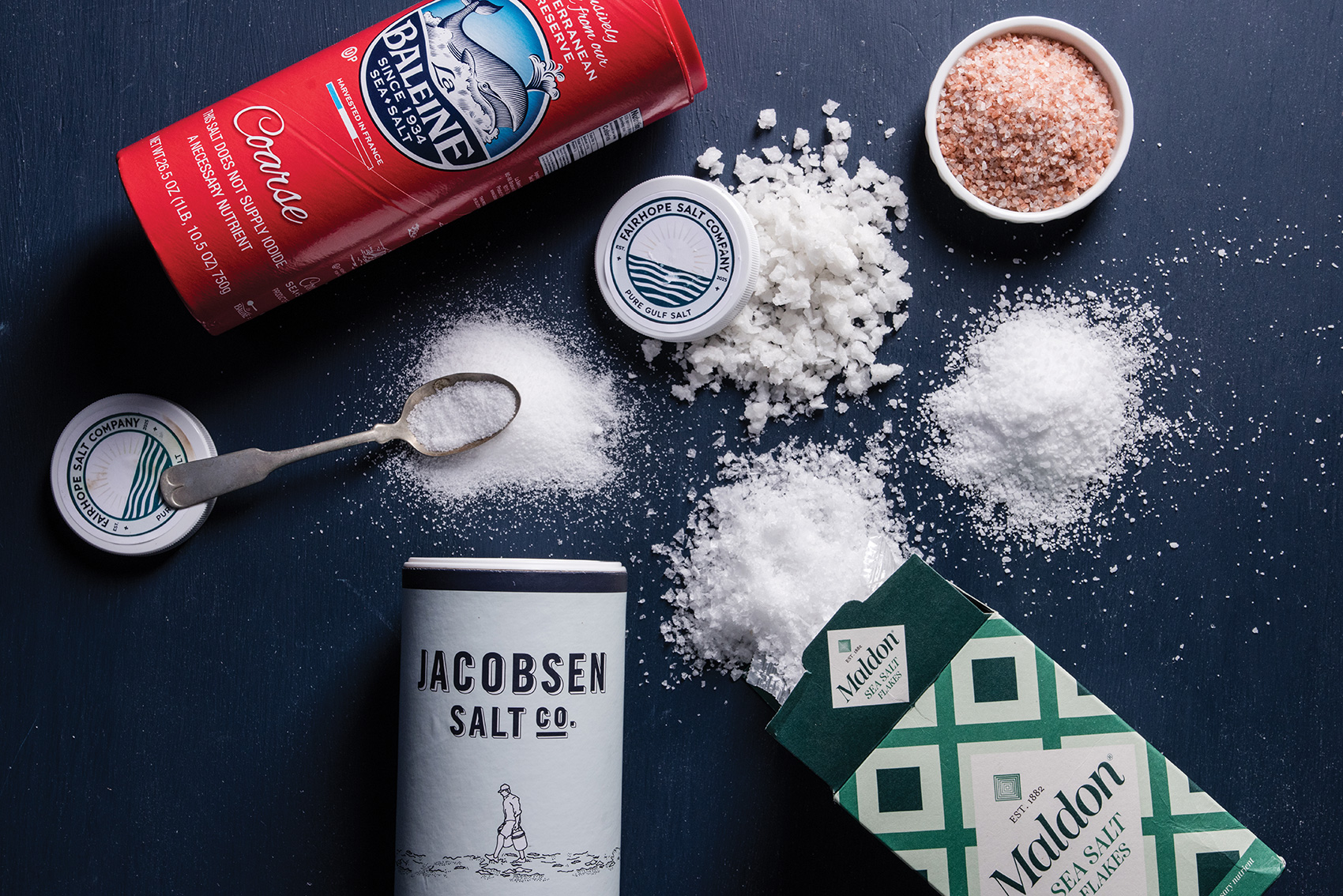
Salt Guide
COARSE SALT
The large-grained salt crystals that make up coarse salt can be further refined into fine salt. It is often used in a grinder for seasoning food.
FLAKE SALT
This salt is best created through a slow evaporation process. Thin and flaky, it is most commonly used for finishing or garnish.
SEA SALT
This salt is harvested from the sea rather than mines. Finer varieties of sea salt, such as Maldon or fleur de sel, take up to a year to produce.
HIMALAYAN SALT
Harvested from mines in Pakistan, this salt is pink due to its trace mineral content. Despite misconception, it is similar to table salt.
KOSHER SALT
Kosher salt loses iodine during the drying process. It it was traditionally used by butchers to ritually cleanse meat and make it kosher.
Alabama’s salt history is far reaching. It begins with the state’s original salt-makers, the Indigenous tribes in the lower Tombigbee River valley. For them, salt was as much a food as it was currency. They obtained it from springs, boiling down the water and drying the salt to use it as a seasoning, preservation and product. In the 1700s and 1800s, settlers preferred importation to harvesting. Salt came in on ships from the Caribbean and Europe, and was mostly used to preserve food before the era of refrigeration. Salt became an especially important factor during wartime, eaten by soldiers and horses alike and used for preservation, curing leather and fertilization. This was especially evident during the Civil War. Six days after the start of the war, President Abraham Lincoln issued a blockade order to stop salt and other necessities from entering the South. “If you stop the supply of salt, you stop the supply of food. Then you win the war,” says King.
As a result, salt was sourced from within, with Clarke County ultimately becoming a major supplier to the Confederate troops, who required 300 million pounds of salt a year. In fact, it was so important that the State General Assembly passed Act 38 on December 9, 1862, creating the Alabama Salt Commission.
The destruction of salt became a tactic of Northern troops, and the most obvious attack happened during the Battle of Fort Morgan. “One of the first things that the Northern soldiers were instructed to do when they got on shore was to go destroy all the salt furnaces and salt cellars,” says King. Troops destroyed the extensive salt mines of Bon Secour Salt Works. The salt industry in Alabama was never the same, and after the war, salt was more often imported than made.
It’s a rediscovery of this tradition that partially motivates King’s work. “When I started really getting bit by this, I went all in and I started learning about the history of salt in Alabama and how important it is,” he says. The process from sea to salt is an involved one. In his work shed, King pours the water from the 5-gallon buckets into a blue 55-gallon drum. He usually lets it sit for a day to allow any particles to settle to the bottom.
Then his filtration process begins through the system that he built himself. “I sell open-source software, and in the tech world, some organizations build their own software and some organizations buy software,” he explains. “I sell to people who build software. I’m always in my head asking, ‘Should I buy it, or should I build it?’ There are advantages and cases for both. This system is the built version.” Although the water he collects looks clean, there is still a trace amount of contaminants that should be removed for the freshest, best-tasting salt.
He attaches clamps to a deep-cell battery that drives a 12-volt transfer pump. The pressure from the pump sucks the water through a hose into the first filter, which is a spin-down filter that catches everything between 50 and 100 microns, filtering out visible contaminants in the water. His system is designed to run at about 180 gallons an hour, totaling somewhere around 3,000 gallons a day. “I don’t run that much water through it currently,” he says. “But its capacity means you have to protect that filter, so you have different stages of filtration.”
A perk of the spin-down filter is that it costs about $25 and can easily be thrown in the dishwasher and reused. After water siphons through the first filter, it enters a pleated polyurethane filter and then goes into an activated charcoal filter. “The activated charcoal will filter out any organic compounds. It has incredible filtration properties.” After the three-step filtration process, the water is funneled into another giant drum.
Batches of the filtered water are then put into a 5-gallon pot to steam. “I can’t boil it,” says King. “If it gets above 170 degrees, it destroys the mineral profile.” The temperature control preserves the salt’s composition while still increasing concentration. The water King gathers from The Hangout, his exclusive collection spot, is about 3% salinity by volume. In order for the water to crystallize and make salt, the concentration has to get to between 25 and 30%. The way to create concentration in the process is to reduce the volume of water.
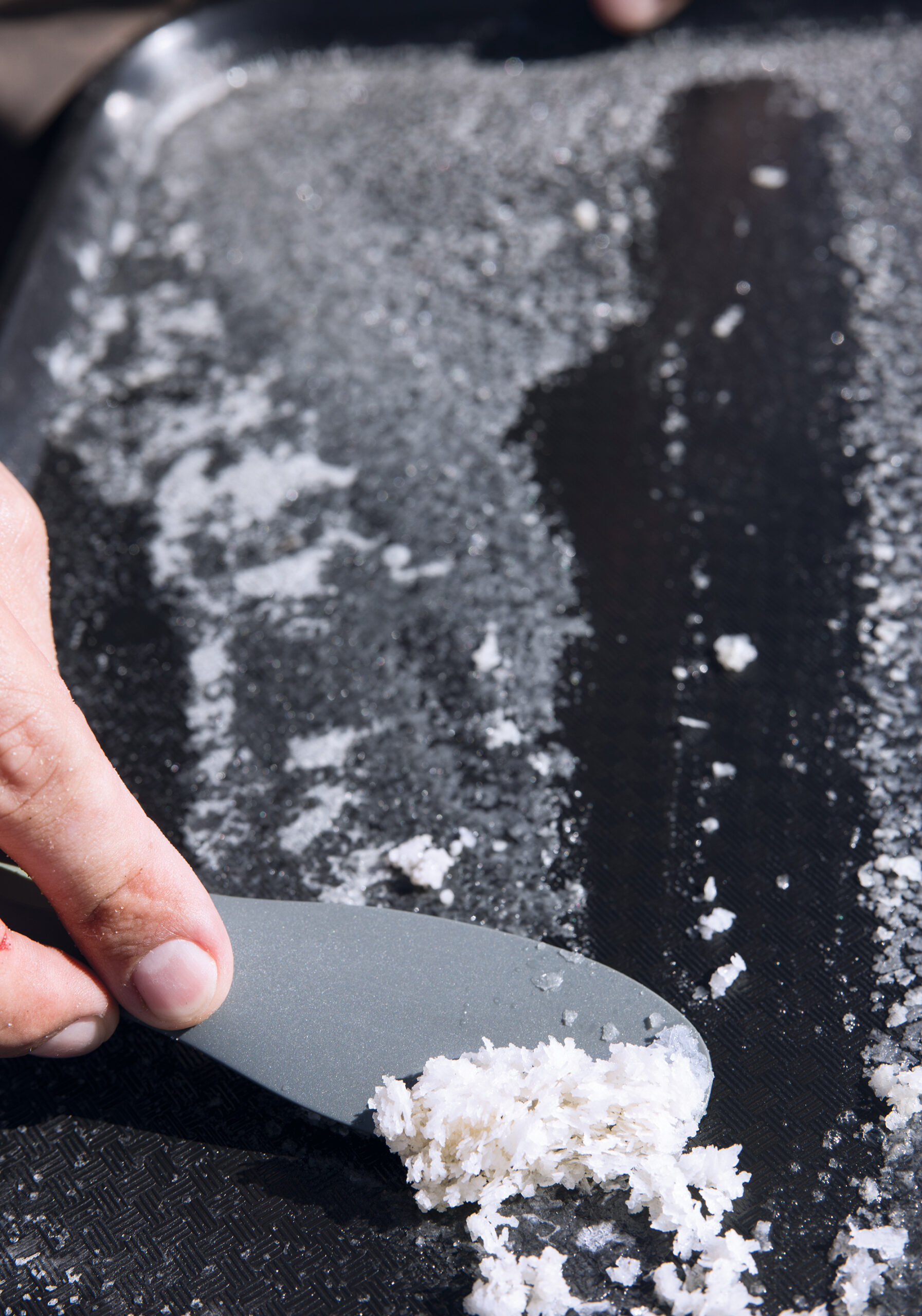
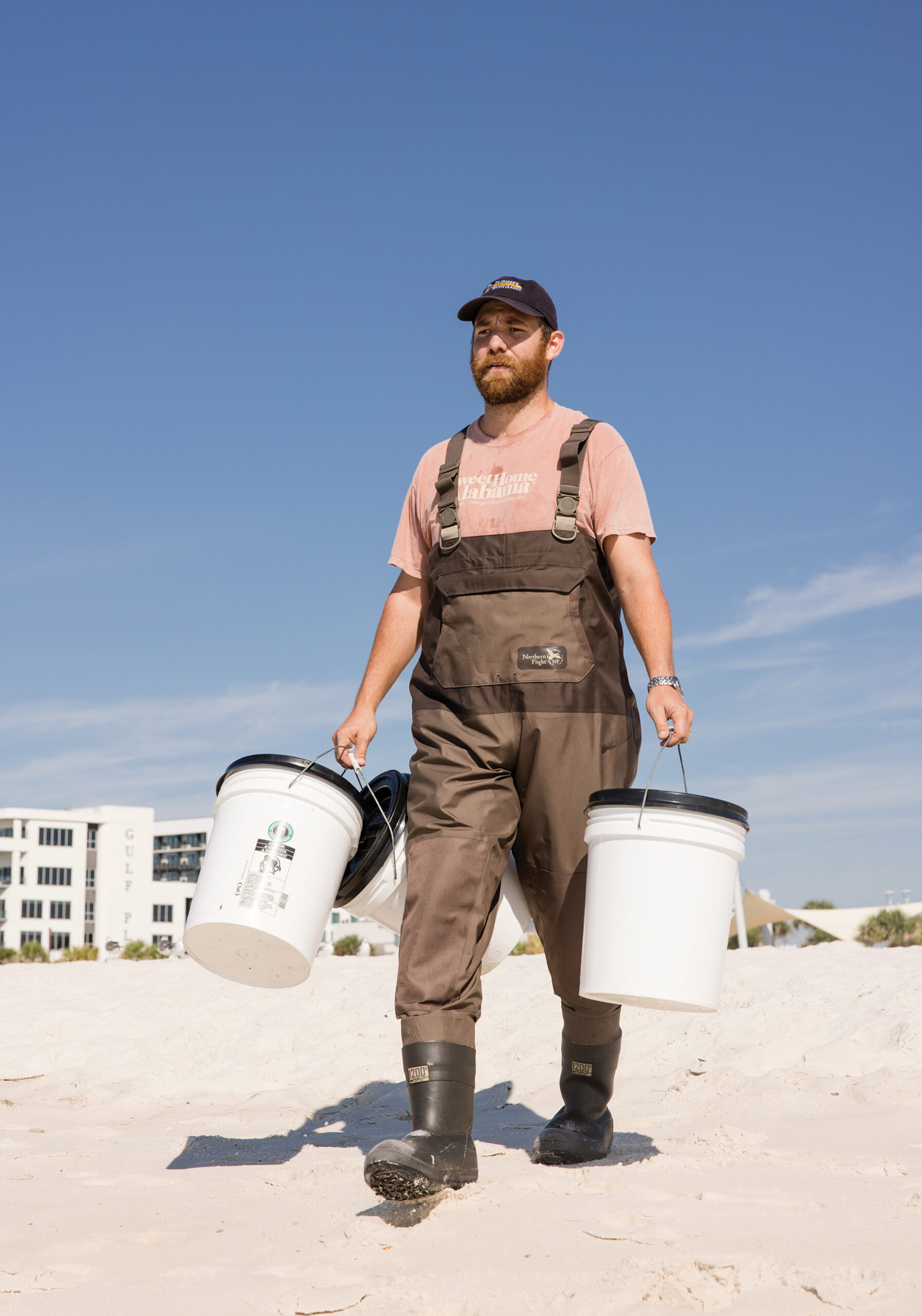
Once the water is concentrated to around 26%, according to King, “it begins snowing.” Little salt particles become visible for the first time in the process, looking like snowflakes as they swirl around the pot. “I remember the first time I tried to scoop those, they just dissolved in the scoop,” he says. When crystallization occurs, the bonds are present but weak. As more salt becomes available in the water, they start to bond together, and as the concentration increases, the bonds grow stronger. Eventually, they get so heavy that they sink to the bottom.
When that happens, it’s time to harvest. King removes the wet salt from the water and has to wash the brine residue off with cold water. To do that, he uses a mug chiller with a four-tap system that he got for free on Facebook Marketplace. “It’s for freezing mugs, but it’s the only thing I’ve found that keeps the water cold enough to wash the salt,” he says.
The salt dries and the process is done, infinitely more satisfying than simply picking up salt from the grocery store. To make good salt, from ocean to jar, King says, takes two weeks. It’s well worth it. “I was born in ‘94, and I feel like our generation was like a McDonald’s and Coke generation,” King says. “I feel like there wasn’t as much of a focus on fresh foods, especially not in the South. I feel like we’re having like a culinary renaissance right now where people care about where their food comes from and they want it to be local if it can.”
King says people should think of salt like they think of oysters. The flavors are different from variety to variety and depend on the environment from which they were harvested. “My salt has this really clean, crunchy flavor that people just haven’t had before,” he says. “If you want to make good salt, you have to get in the water, and you’ve got to earn it. I got to know the process, like front and backwards, and I had to have all the scars, bumps and bruises to show for it.”
For King, the pinnacle of the process is seeing the crystals and tasting the product. The result is hard, crystalline pyramids. The salt is three grades of sea salt in one. Processing can separate it into flake salt, sea salt and fine-grain sea salt. “Every time I look at it, get my hands on it and rub my fingers through it, it’s like, ‘I made this.’ Like, ‘I made it and, damn, that stuff’s salty.’ Just the fact that I’m able to make that from seawater is still just the craziest dang thing.”
He most enjoys his salt sprinkled over fresh-baked focaccia bread, in brown butter sea salt cookies, on fresh vegetables — it goes well on just about everything. “It’s about texture, it’s about clarity,” he says. “When people have my salt, I want them to feel like they’ve never had salt before in their life. Salt isn’t just an ingredient. It can transform a simple food.”
Fairhope Salt Company • fairhopesaltcompany.com
4 Fairhope Salt Company Recipes to Try
Salted Rosemary Focaccia

SERVES 8
Ingredients
3 1/4 cups all-purpose or bread flour, divided
1 3/4 cups room-temperature water, divided
1 1/2 teaspoons bread machine yeast, divided
2 teaspoons kosher salt
1 tablespoon olive oil (plus more for pan and topping)
2 – 3 garlic cloves, thinly sliced
1 tablespoon fresh rosemary, chopped
Fairhope Salt Company flake salt, for topping
Directions
1. In a large bowl, combine 1/2 cup flour, 1/2 cup water, and 1/4 teaspoon yeast. Cover and rest 30 minutes to 1 hour at room temperature.
2. Mix remaining flour, water, yeast and salt with the pre-ferment until combined. Rest 1 hour.
3. Add olive oil and fold dough 4–5 times. Cover and place in refrigerator for up to 24 hours, or proof 2 hours at room temperature.
4. Transfer dough to a heavily oiled baking pan. Stretch gently, cover and let rise at room temperature for 2 more hours.
5. Preheat oven to 500 degrees. Dimple dough with fingertips, drizzle generously with oil and top with garlic, rosemary and a large helping of flake salt.
6. Bake 20–30 minutes until golden. Cool 10 minutes before slicing. Serve warm.
Salted Pecan Pralines
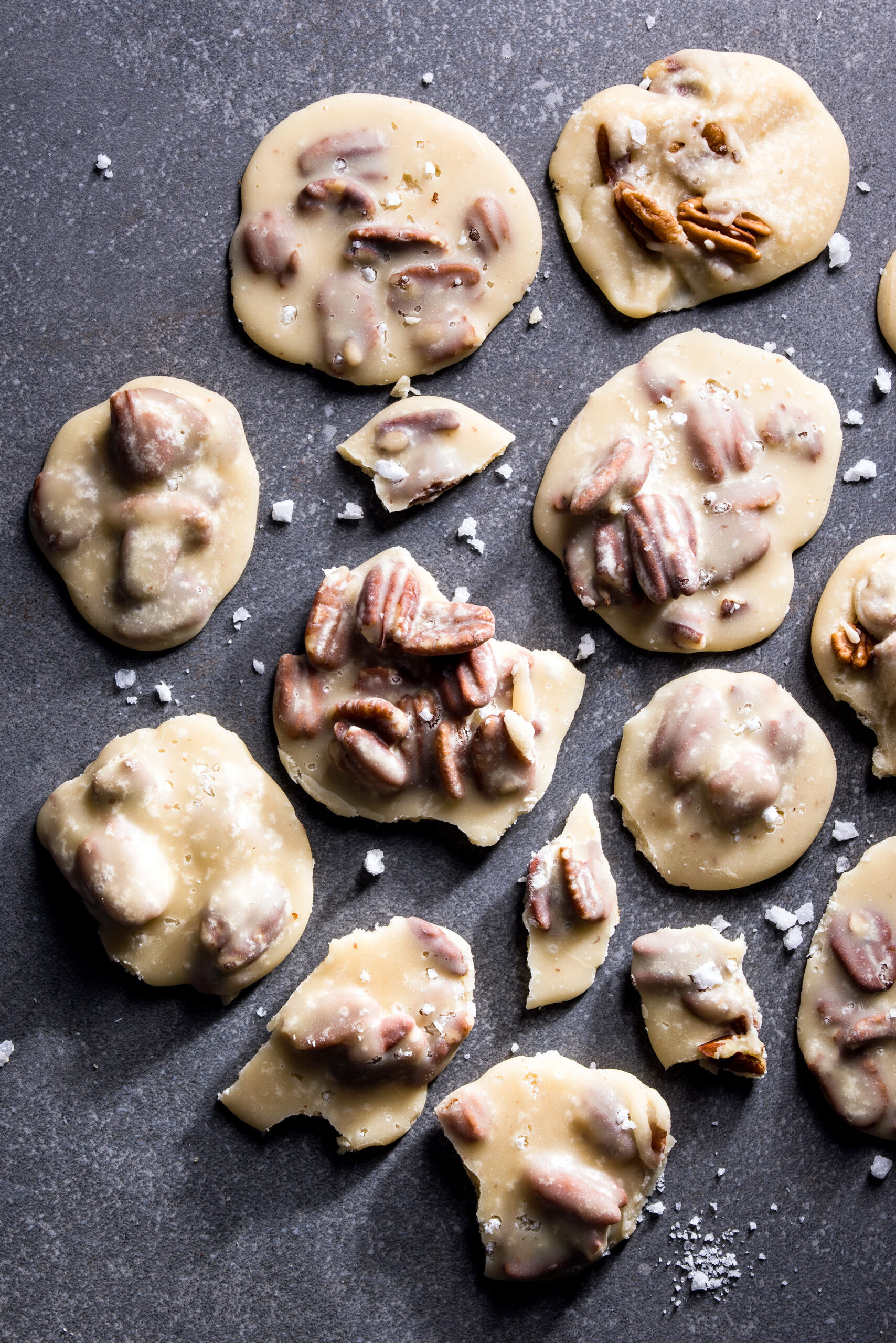
MAKES 15 – 20
Ingredients
1 1/2 cups pecan halves
1 1/2 cups granulated sugar
3/4 cup heavy cream
1 stick unsalted butter, cubed
1/4 cup light corn syrup
1/4 teaspoon fine sea salt
1/2 teaspoon vanilla extract
Fairhope Flake Salt, for topping
Directions
1. Preheat the oven to 350 degrees. Put pecan halves on a baking sheet and toast in the oven for 8 minutes.
2. In a saucepan, combine sugar, cream, butter, corn syrup and salt. Bring to a boil until it reaches the softball stage (a temperature of 236 – 240 degrees). Remove from heat. Stir in pecans and vanilla and stir until slightly thickened.
3. On a parchment-lined baking sheet, drop spoonfuls of the mixture. Sprinkle a few Fairhope Flakes on each praline.
4. Cool about 30 minutes until set and serve. Store leftovers in an airtight container.
Citrus Olive Oil Cake
SERVES 10 – 12
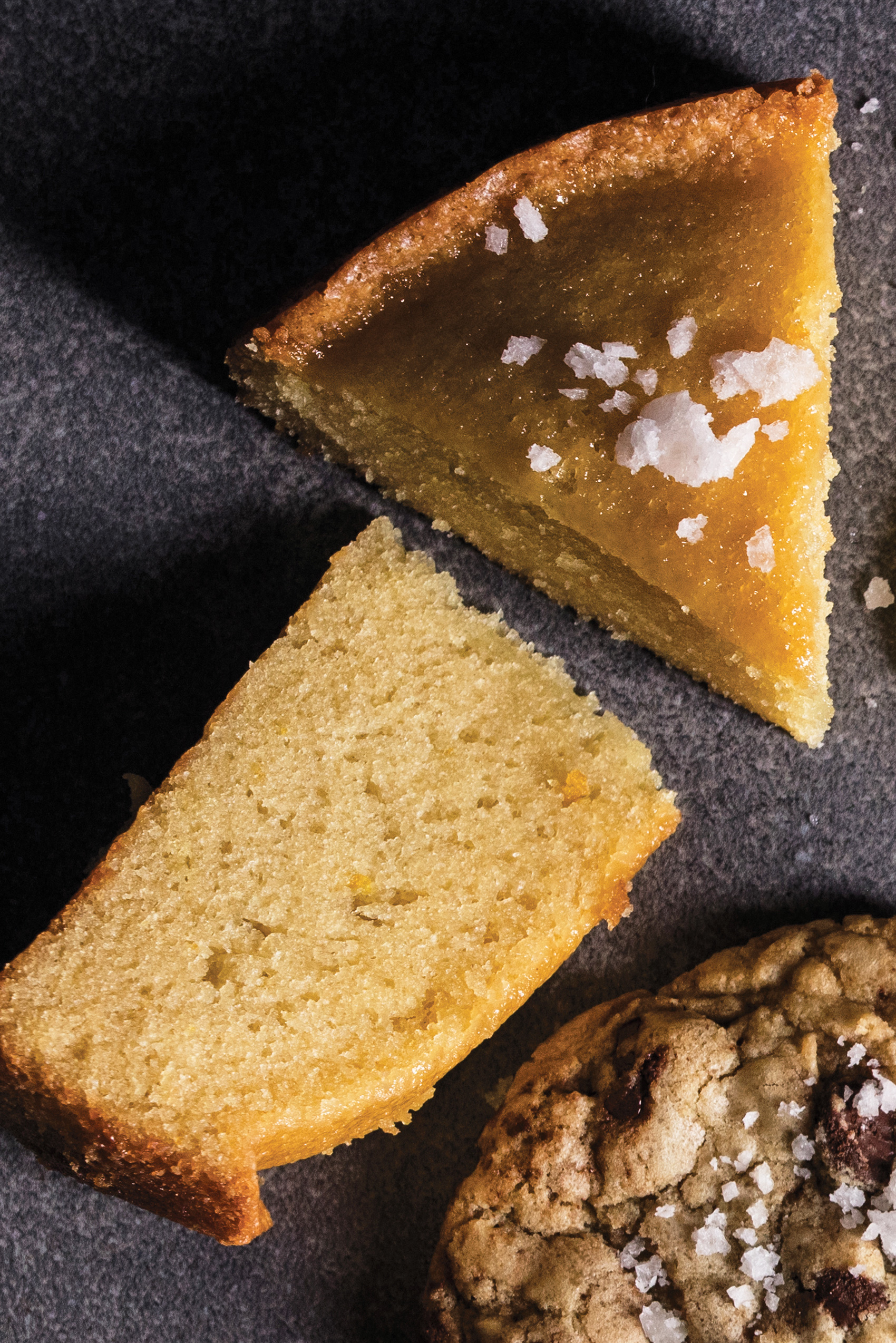
Ingredients
2 cups all-purpose or cake flour
1 3/4 cups granulated sugar
3/4 teaspoon baking powder
1/2 teaspoon baking soda
1/2 teaspoon fine salt
3 large eggs
Zest of 2 Baldwin County satsumas
1/2 cup fresh satsuma juice
1 1/3 cups extra-virgin olive oil
1 cup whole milk
2 tablespoons heavy cream
1/4 cup Grand Marnier or other citrus liqueur, optional
Fairhope Flake Salt, for finishing
Directions
1. Preheat oven to 350 degrees. Grease and line a 10-inch cake pan with parchment.
2. In a large mixing bowl, whisk together flour, sugar, baking powder, baking soda and salt.
3. In a separate large bowl, whisk eggs, satsuma zest, satsuma juice, olive oil, milk, cream and liqueur (if using).
4. Pour wet into dry and stir just until combined. Do not overmix.
5. Transfer batter to the pan and bake 35 – 45 minutes, or until a toothpick inserted comes out clean.
6. Cool in pan about 15 minutes, then remove to a cooling rack to completely cool. Just before serving, sprinkle lightly with Fairhope Flake salt.
Brown Butter Sea Salt Cookies
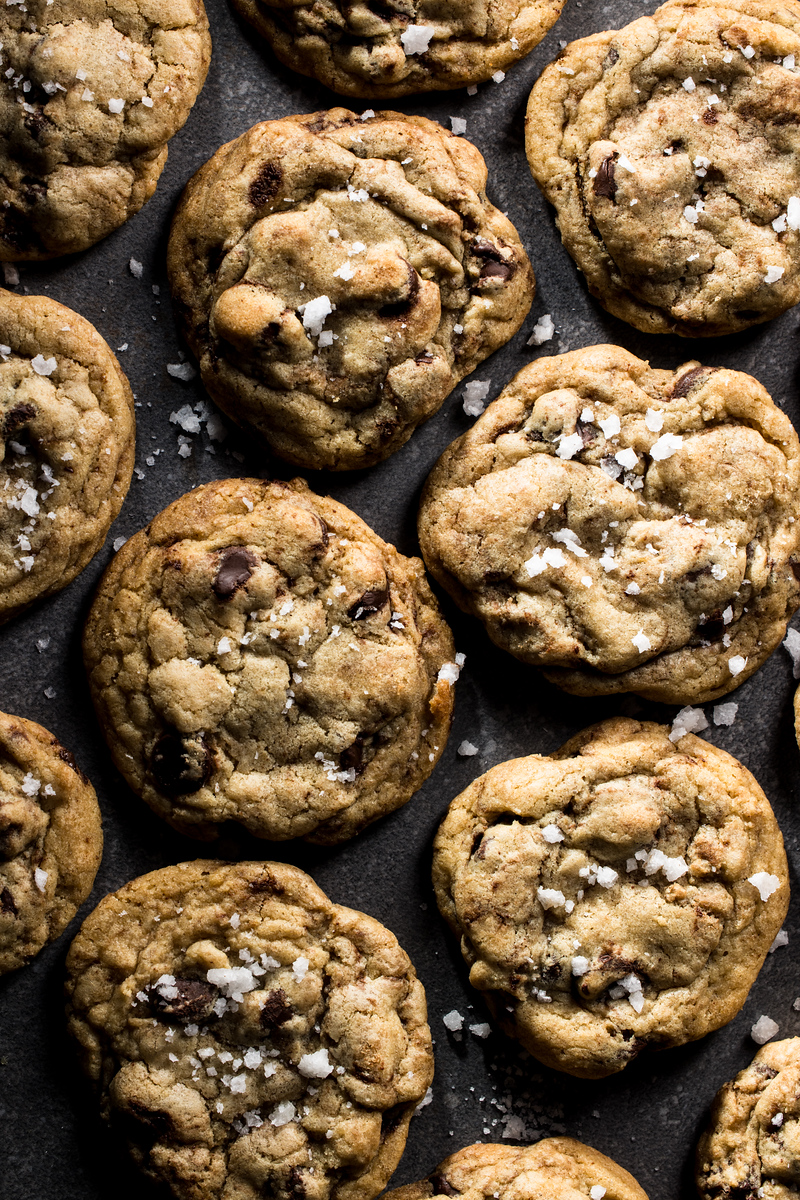
MAKES 23 COOKIES
Ingredients
1 cup unsalted butter
1 cup packed dark brown sugar
1/2 cup white sugar
2 large eggs
2 teaspoons vanilla extract
2 1/4 cups all-purpose flour
1 teaspoon baking soda
1/2 teaspoon salt
1 1/2 cups dark chocolate chips
Fairhope Flake Salt, for finishing
Directions
1. In a small saucepan, melt butter over medium heat. Cook 5 – 7 minutes, swirling, until browned and nutty. Cool slightly.
2. In a mixing bowl, whisk browned butter, brown sugar and white sugar until smooth. Beat in eggs and vanilla.
3. In another bowl, whisk flour, baking soda and powder salt. Fold dry mix into wet until just combined. Stir in dark chocolate chips. Cover and chill dough for at least 1 hour (or overnight for deeper flavor and thicker cookies).
4. When ready to bake, preheat oven to 350 degrees and remove dough from refrigerator. Let sit for 10 minutes, or until softened and scoopable. Scoop dough into 1/4 cup mounds onto parchment-lined baking sheets.
5. Bake 12 – 14 minutes, until golden at edges but soft in center. While still warm, sprinkle generously with Fairhope Flake salt. Let cool and serve.
Cook’s note: For extra thickness, you can freeze dough balls for 1 hour before baking.


